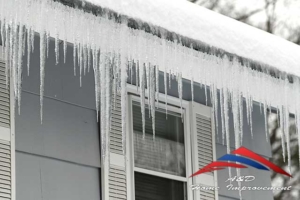We were hoping that 2021 was going to be better than 2020, but everyone knows that the huge amount of snow that was dumped on Chicago during February, combined with temperatures that rival anyone’s deep freezer, Chicagoans are having a real problem with ice dams.
What Are Ice Dams?

During heavy snowfalls, snow collects on the top of the roof. If the roof is poorly insulated, heat from inside the house makes the upper portions of the roof warmer, so the snow begins to melt. This sounds like a good thing, right?
The problem occurs when the snowmelt hits a part of the roof (usually near the eves) that is not warm. The water refreezes and turns to ice.
The ice forms a thick barrier, sometimes several inches thick, as the snow continues to melt from the top area of the roof and then refreezes in and around the eves.
The majority of ice dams form due to a very warm attic that has not been properly insulated. Attics with poor ventilation can also cause ice dams.
Ice Dams Can Cause Substantial Damage
Ice damming frequently occurs when temperatures are slightly above freezing during the day but below freezing at night. When this happens, ice dams can form, no matter how well insulated your attic might be.
If left untreated, ice dams can literally tear the gutters off of the house and cause significant roof damage as shingles come loose or even pulled off.
When shingles are loose, they allow water to flow underneath and leak into your home. If you see water stains on your ceiling, this is a sure sign that the roof leaks have occurred due to roof damage from the ice dam.
Water that does not drain off the roof can also find its way under the shingles, into the attic, and flow down the inside of the walls, seep through some types of insulation, and cause damage to the paint, floors, ceilings, and electrical outlets.
When temperatures warm up later this year, places that do not dry can even form mold and mildew, which is something no one wants to deal with!
The Do’s and Don’ts of Ice Dams
Those long icicles hanging off of the eves are definitely pretty, but they are often the first sign of an ice dam.
The best things you can do if you suspect your home might have an ice dam are:
- DO use a roof rake (not your garden rake) and pull off as much snow as possible while you are standing on the ground.
- DO take a box fan or other type of fan and place it in the attic. Aim it at the underside of the roof. If you can a wet-looking area on the inside of the roof, aim the fan at that location.
- DO keep your downspouts clear of debris.
Perhaps more important than the dos are the don’ts if you have or suspect you have an ice dam.
- DON’T turn up the heat inside your house in an attempt to melt the ice.
- DON’T climb onto the roof or even put a ladder next to the roof.
- DON’T use rock salt on your roof.
- DON’T try to chip away at the ice, attempt to break the ice. Not only is it dangerous to use a ladder in icy conditions, but you might cause more damage to the roof by trying to chip away at the ice.
- DON’T remove so much snow you can see the shingles. A thin layer of snow is fine.
- DON’T try to use heated cables or other devices to melt the ice.
- DON’T break off icicles as this can cause the snow backed up behind them to come crashing down on YOU.
- DON’T walk directly under large icicles or near roofs that have a heavy load of snow.
After All is Said and Done
Chicago and the surrounding suburbs, such as Elk Grove Village, will thaw out in time. It might not feel that way right now but time continues onward and the snow will melt sooner rather than later.
You should call the professionals at A&D Home Improvement. When the weather warms up a bit, we will be able to inspect your roof and advise you about what repairs your roof might need.
There are multiple ways to lessen the possible damage from ice dams and your solution will be unique to your home. Some of the best options include:
- Insulating the attic or improving the insulation that is currently in place.
- Improving the ventilation system in the attic.
- Reposition rain gutters.
- Install heating cables near the eaves and downspouts.
Of course, any of the above will need to be done after the roof has been repaired.
Got an Ice Dam? Call the Professionals at A&D Home Improvement
A roof covered in ice is too dangerous even for the professional roofers at A&D. We will be happy to make an appointment in the future, however, so we can do a full inspection of your roof.
A&D Home Improvement services Elk Grove Village, Wood Dale, Des Plaines, Arlington Heights, the city of Chicago, and nearly all suburbs in the greater Chicago area. Our professional team of roofers knows your neighborhood and they know what your home needs after ice damming has caused damage to your roof!
We work with all insurance companies and will take care of all the details. With A&D Home Improvement, one call and it’s done!
Call Steve in Scheduling today at 847-916-0600 and get your roof repaired so you can enjoy a stress-free spring and summer!



